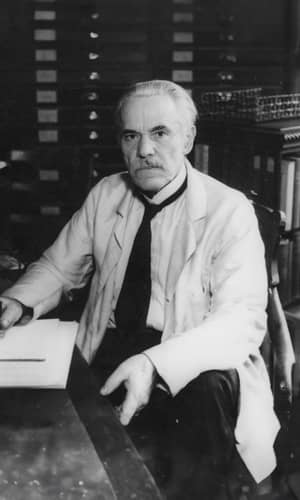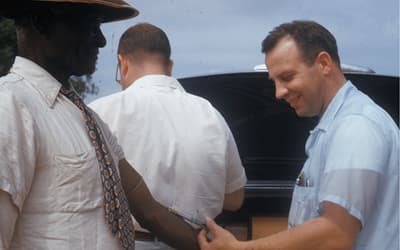The views expressed in this paper are those of the writer(s) and are not necessarily those of the ARJ Editor or Answers in Genesis.
Abstract
In the early twentieth century, human remains, including skulls and brains, were collected by evolutionists seeking to validate human evolution and justify racism. These collections were housed in leading academic institutions, including the Smithsonian, Harvard, and the University of California, Berkeley. A key figure in the formation of these collections was Aleš Hrdlička, founder and first curator of the Physical Anthropology Department at the Smithsonian Museum of Natural History. Hrdlička published prolifically to support his evolutionary and racist preconceptions. In the end, these collections offered little support for the racist and evolutionary views of Darwinists in the last century. They also were an attempt to deny the clear teaching of Genesis that all humans are descendants of the first humans, Adam and Eve: “God made from one man every nation of mankind that lives on the face of the earth” (Acts 17:26. See also 1 Corinthians 15:45 and Genesis 3:20). Thus, there is only one race, the human race.
Keywords: anthropology skeleton collections, eugenics, Aleš Hrdlička, racism, Nazi Germany, Smithsonian, human evolution, Charles Darwin, evolution
Introduction
The modern movement to expose the scientific racism of America’s past has identified numerous racist-eugenic examples in our leading academic institutions. The Washington Post undertook a project to expose the scientific racism of America’s past in academia. They uncovered many “century-old, racially based injustices that have plagued communities in our backyard and around the world” (WashPostPR 2023). For example, the Smithsonian Museum of Natural History held the world’s largest scientific repository of human remains focusing on documenting evidence for human evolution and the resulting racism (Randall 2018). Most of the different skeletal and brain collections used to support racism were housed in large leading universities.
Among the many egregious examples that have been uncovered include those at Harvard University, which has housed thousands of skeletons collected “from the most marginalized and powerless groups” in America (Alex 2023, 35). The University of California, Berkeley, anthropology museum also holds the bones of over 9,000 indigenous individuals. The University of Illinois holds 7,503, the University of Kentucky 4,504, and the U.S. Department of the Interior 2,970 (Alex 2023, 37). The academic anthropological skeleton collections also often included body organs.
Nazi Jewish Skeleton Collection
The Nazi Jewish skeleton collection in Germany is widely known, but it surprised many historians to discover similar academic collections in America. Furthermore, these different skeleton collections were produced for nearly the same reasons. As summarized concisely by Wikipedia:
The Jewish skull collection was an attempt by the Nazis to create an anthropological display to showcase the alleged racial inferiority of the “Jewish race” and to emphasize the Jews’ status as Untermenschen (“sub-humans”), in contrast to the Germanic race, which the Nazis considered to be superior. The collection was to be housed at the Anatomy Institute at the Reich University of Strasbourg in the annexed region of Alsace, where the initial preparation of the corpses was performed. (Wikipedia 2023)
Likewise, decades ago the American population widely regarded its native Indian population as evolutionarily inferior to the White population. For example, in 1850, “Most Californians of that time assumed that their growing state’s Indian tribes belonged to an earlier, inferior evolutionary state—and were doomed to extinction. The land’s first peoples would evaporate ‘like the dissipating mist in the presence of the morning sun’” (Starn 2004, 24).
The famous anatomist Paul Broca (1824–1880) had the honor of having part of the brain named after him (Broca’s area, which is involved with language). He believed the brain to be “larger in men than in women, in eminent men than in men of mediocre talent, [and] in superior races than in inferior races.” He also proposed that “Negroes were an intermediate form between apes and Europeans” (Ashok 2017, 32). In “Broca’s brand of Social Darwinism . . . a lesser native intelligence impaired ‘lower’ groups [of people which] explained colonialism, slavery, and patriarchy” (Starn 2004, 176). Until Franz Boas (1858–1942) revolutionized anthropology, the field of anthropology
had been mired in . . . . the assumptions of white superiority and Social Darwinism so prevalent in the Victorian age. Nineteenth century anthropologists ranked the world’s people from savage to civilized, placing ‘Caucasians’ at humanity’s apex. The darker races were assumed to be inferior in intelligence and thus handicapped in the climb up the ladder of human evolution. Anthropology’s ‘scientific’ racism justified Europe’s aggressive expansion—and both the enslavement of Africans and confinement to reservations of Native Americans. (Starn 2004, 51)
Even among those nineteenth-century scientists who accepted [the belief that] we all belong to one species . . . it was generally agreed that the lesser races were less evolved or, alternatively, had ‘degenerated’ from the white standard. (Starn 2004, 176)
Professor Aleš Hrdlička
One of the most productive early evolutionary racists of the last century was Aleš Hrdlička (1869–1943). Historian Mark Brandon was the author of the most authoritative comprehensive study of the work and person of Professor Hrdlička titled The Perils of Race-Thinking: A Portrait of Aleš Hrdlička. Hrdlička was an enormously active world-class scientist. Reared a Christian, he rejected creationism and “energetically supported Darwinism,” spending the rest of his life attempting to bolster Darwinism (Brandon 2023, 202) (fig. 1). Hrdlička was a central figure in the international anthropology movement of the early twentieth century.

Fig. 1. The cover of The Perils of Race-Thinking: A Portrait of Aleš Hrdlička by Mark Brandon, 2023. The definitive study of Aleš Hrdlička and his support of Darwinism and racism.
According to Hrdlička’s “scientific worldview, there were [distinct human] races, they were unequal, and they were locked in a Darwinist struggle for survival” (Brandon 2023, 5). Furthermore, “race-thinking was at the core of Hrdlička’s Czech nationalism, which was the beginning point for his racial description of the whole world” (Brandon 2023, 4). Brandon documented that even when the facts he unearthed in his research contradicted his racist Darwinian worldview, his faith in Darwin blinded him to the reality before him (Brandon 2023, 6).
Some of Hrdlička’s research was directed toward documenting diseases in persons of inferior races, research which could be used to help them. For example, he did a study of American Indians noting “the morbidity and mortality from all forms of tuberculosis among the Indians today exceed by far those among the whites generally; and that their average exceeds even the very high rate among American negroes” (Hrdlička 1909, 6). He recognized the unsanitary conditions they lived in was a major part of the reason for these high rates, but noted part of the solution was “civilizing . . . the race” of Indians and dealing with the “other pathological conditions to which he is subject” (Hrdlička 1909, 36).
Although Hrdlička saw Slavs and Germans as physically different, they “both belonged to the White race which, Hrdlička thought, was superior to the ‘Yellow-Brown’” race and far superior to the Black race (Brandon 2023, 4). He disagreed with the Nazi ideas because, he concluded, the Slavs, not the Nordics, were the most eugenically fit biological racial “strain.” Furthermore, the United States population was White, but not the ideal pure White, because, Hrdlička concluded, due to some mixing with the Black slave population.
Hrdlička’s Professional Career
Originally trained as a medical doctor, in 1894, Hrdlička quit his private medical practice and accepted a position at the New York College for the insane, where he became very interested in eugenics. Eugenics is the belief that some races were less-evolved than persons of other races. Consequently, the less-evolved persons should be prevented from, or at the very least discouraged from, reproducing and the more-evolved persons encouraged to reproduce. His next position was as a field anthropologist studying the different races under the direction of Harvard University anthropologist Frederic Putnam (Spencer 1997, 503). He founded, and became the first curator, of the physical anthropology department of the U.S. National Museum (now the Smithsonian Institution National Museum of Natural History—NMNH), a position that he held for the next 37 years.
Under Dr. Hrdlička’s leadership, the Smithsonian Institution collected thousands of brains from indigenous peoples as part of their early-twentieth century effort to promote the support for, and the study of, Darwinism. Today the Smithsonian is the world’s largest scientific repository of human remains (Randall 2018). At one time, over 30,000 specimens were stored there. Many of the remains were taken from native peoples without their permission.
Ishi’s Brain
One of the most detailed examples of the harm done by anthropological leaders was documented in the book Ishi’s Brain. Ishi was by historical consensus the last wild Indian in the United States living traditionally outside of a reservation and the direct constraints of Anglo-American society or government. Ishi was found in 1911 by scientists in a desperate condition when he was about the age of 50 near Oroville, California. After dying of tuberculosis in 1916, his brain was sent to the Smithsonian to add to their growing collection of “inferior,” “less-evolved” humans (Starn 2004).
The main motivation for the brain collections was to document the racist belief, then widely held in academia, that some people were lower on the evolutionary ladder than other people (WashPost 2023). These scientists were looking for aspects of the brain that were smaller or less-developed in the brains of those persons believed to be less-evolved. The late Harvard University professor, Steven Jay Gould, coined the term “scientific racists” for those who attempted to base their racism on science, especially Darwinism (Gould 1996). This category would include Hrdlička. The measurements and terms included in Hrdlička’s publications reflect his Darwinian, eugenic, racist worldview. Examples include: “full blooded American Negro” and his “very thick lips” and “coconut shaped head” (Starn 2004, 179).
Hrdlička and Eugenics
In 1926, Hrdlička became an advisory member of the American Eugenics Society (Dungca 2023). He collected what today is called a “wet” collection, that is, soft tissue, especially human brains, in an effort to document his Darwinian-based belief that some races were more highly evolved than others (West 2023). In his book The Perils of Race-Thinking, Brandon included an entire chapter on Hrdlička’s extensive eugenic activities (Brandon 2023, 157–175). Hrdlička eventually collected hundreds of brains from more than 80 countries. The most “inferior” race, according to Hrdlička, was the Blacks (whom he referred to as the Negroid “race”) (Brandon 2023, 139). His conclusion was based firmly on Darwinism (Brandon 2023, 4, 5, 8, 109, 191, 201–202, 220).
Hrdlička’s views were similar to those of his fellow anthropologists: “for Hrdlička, as for many other intellectual leaders of his age, race seemed to embody a ‘scientific world view,’ which was in sync with ‘Darwinism,’ ‘biology,’ and ‘nature,’ but in contrast to the churchy ‘superstition of earlier times’ [that believed all races were equal]” (Brandon 2023, 4–5).
Other scientific racists believed that the most primitive human races, lower even than African Blacks, were the Hottentots and Australian aborigines (Gould 1996, 117–118). Charles Darwin agreed with this assessment and concluded that the “European view [was] that . . . so-called Hottentot women provided a ‘somewhat primitive, grotesque nature of black female sexuality’” (Holmes 2020, 14). Darwin used the term “Hottentots” in derogatory ways at least seven times in his writings (Darwin 1871, vol. 1, 216, 218, 220, 225; vol. 2, 334, 343, 352).
The Evidence Fails to Support Evolutionism or Racism
The scientists behind the skeleton/body organ collections firmly believed in human evolution. They were collecting the brains and skeletons of those they saw as inferior races to prove evolution, but never got very far because, in the end, the material did not support evolution. They did not publish details of their disappointment, but quietly went on to other pursuits and the huge skeletal and brain collections were put in storage where they remained until recently. Eventually, the collection of brains and skulls forced a rejection of “the dogma of Social Darwinism and assumptions of race and gender supremacy” (Starn 2004, 178). Hrdlička resisted discarding his racist ideas, but he too eventually came around to oppose eugenics. He even signed a 1936 statement against Nazism “albeit in the most cautious terms” (Starn 2004, 179).
Summary
Committed Darwinist and racist, Aleš Hrdlička served as Curator of Physical Anthropology at the prestigious Smithsonian Institution for 37 years, from 1904 to 1941. He “was both a world-renowned scientist and a propagator of abhorrent racial views” (Brandon 2023, 7). This fact illustrates how entrenched Darwinian racism was in American academia in the early part of the last century. It also illustrates the enormous harm that Darwinism has caused to American society.
The fact is, Hrdlička “hurt many people by using his authority as a scientist to make race thinking acceptable . . . . To many people, he represented the victory of modern science over religious superstition. In the age of the Scopes Trial, he energetically supported Darwinism over Creationism” (Brandon 2023, 202). He not only rejected Christianity, but wanted to replace it with a superior belief, specifically science, which was what he thought was our new savior. His “science as the new savior,” being his life work, as this review documents, did not turn out very well (Brandon 2023, 177). His version of Darwinism “went beyond a simple description of evolutionary biology; it was a moral prescription for human behavior. Humans were animals and animals belonged in zoological groups. These biological groups engaged in ‘struggle,’ in which the stronger triumphed over the weaker” (Brandon 2023, 200). Furthermore, his version of Darwinism necessarily produces superior and inferior races.
Unfortunately, due to this entrenched racism some valid scientific discoveries were misused. For example, the discovery of human blood groups in and around 1900 galvanized not only myths about blood and race, but also provided a new line of anthropological support for eugenics in the 1920s and 1930s (Boaz 2012) (fig. 2). This entire racist history of science is now recognized as a profound embarrassment. It was only one of many examples of the tragedy that resulted from rejecting the Genesis teaching that all human people groups are descended from the first couple, Adam and Eve. Thus, “race” as a genetic reality does not exist biologically because all humans are part of one race, the human race.

Fig. 2. The cover of In Search of “Aryan Blood:” Serology in Interwar and National Socialist Germany by Rachel Boaz, 2012. The most definitive study of the misuse of blood groups to defend racism.
References
Alex, Bridget. 2023. “A Skeleton’s Story: The Dark History of University Bone Collections.” Discover 44 (September/October): 32–41.
Ashok, Samantha Sharon. 2017. “The History of Race in Anthropology: Paul Broca and the Question of Human Hybridity.” Anthropology Senior Theses. University of Pennsylvania.
Boaz, Rachel. 2012. In Search of “Aryan Blood:” Serology in Interwar and National Socialist Germany. Budapest, Hungary: Central European University Press.
Brandon, Mark A. 2023. The Perils of Race-Thinking: A Portrait of Aleš Hrdlička. Budapest, Hungary: Central European University Press.
Dungca, Nicole et al. 2023. “The Smithsonian’s ‘Bone Doctor’ Scavenged Thousands of Body Parts.” The Washington Post. https://www.washingtonpost.com/history/interactive/2023/ales-hrdlicka-smithsonian-brains-racism/.
Gould, Stephen Jay. 1996. The Mismeasure of Man. New York, New York: W. W. Norton & Co.
Holmes, Rachel. 2020. The Hottentot Venus: The Life and Death of Saartjie Baartman (Born 1789–Buried 2002). London, England: Bloomsbury Publishing.
Hrdlička, Aleš. 1909. Tuberculosis Among Certain Indian Tribes of the United States. Washington, D.C.: Smithsonian Institution.
Randall, Kayla, 2018. “How the Smithsonian Is Reuniting Thousands of Human Remains with Indigenous Communities.” https://washingtoncitypaper.com/article/183464/how-the-smithsonian-is-reuniting-thousands-of-human-remains-with-indigenous-communities/.
Spencer, Frank. ed. 1997. History of Physical Anthropology: An Encyclopedia. New York, New York: Garland Science.
Starn, Orin. 2004. Ishi’s Brain: In Search of Americas Last “Wild” Indian. New York, New York: W. W. Norton & Company.
WashPostPR. 2023. “New Investigative Series from The Washington Post reveals the Smithsonian’s ‘Racial Brain Collection’.” The Washington Post, August 14. https://www.washingtonpost.com/pr/2023/08/14/new-investigative-series-washington-post-reveals-smithsonians-racial-brain-collection/.
West, John G. 2023. “Smithsonian’s Racist Brain Collection Exposed by Washington Post.” Evolution News & Science Today, August 17. https://evolutionnews.org/2023/08/smithsonians-racist-brain-collection-exposed-by-washington-post/.
Wikipedia. 2023. “Jewish skull collection.” 2023. https://en.wikipedia.org/wiki/Jewish_skull_collection.









